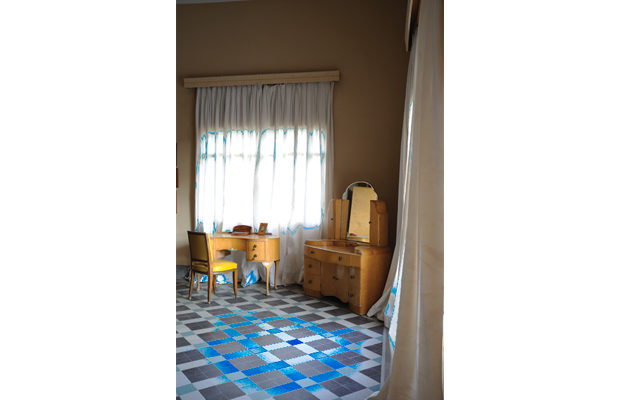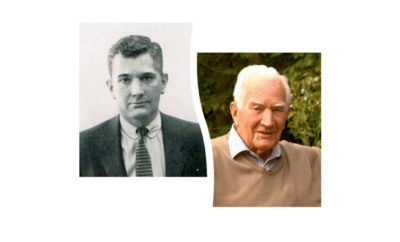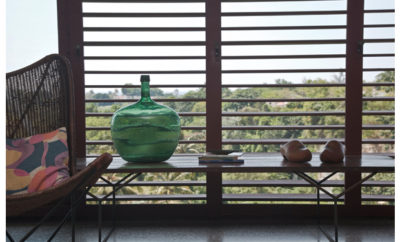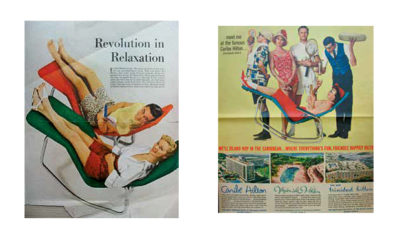
Feature
Moroccan Majesty

Art deco vanities purchased from a dealer in Normandy.
Do you believe in love at first sight, a love that conquers all? If you do, the story of Christine and Aziz Alaoui and their remarkable seven-acre art deco Eden, Villa Bled Roknine—a three-story, ten-thousand- square-foot concrete and stone main house, plus guesthouse, water tower, and lush gardens, all created by Paul Sinoir for the Audibert family between 1928 and 1930 in Marrakech’s Palmeraie district—will reaffirm your magical thinking. If not, the tale is one for the Arabian Nights, relayed with relish by Christine Alaoui and the New York-based artist Yasmina Alaoui, one of the family’s three children.
Christine and Aziz Alaoui first visited Bled Roknine in 1989 with a French friend who wanted to share the mystery of the place, which was something of a local legend with a history veiled in obscurity. The property’s original owners had abandoned it sometime after the end of the French Protectorate of Morocco in 1956.
As the Alaouis later learned, the Audiberts hailed from southern France; their family business included the famed shop Le Petit Savon de Marseille.
“The caretaker was still living on the land with his family,” says Christine Alaoui. “But the owners were no longer paying him, so he gave tours of the property to make ends meet.” For the Alaouis, just walking through the gardens and seeing the exterior of the house proved life-changing. “We not only fell in love with the house because of its beauty and mystery, but were in a state of shock because of its exceptional size. The homes designed by European architects in the 1930s tended to be on a much smaller scale.”
The two decided that day that they would do whatever it took to possess the property, even though they had not had even a glimpse into the interior. “The whole process was very complicated because the title still belonged to the French,” Mrs. Alaoui says, “but by law the place had become a property of the Moroccan government, which had not legally claimed it yet. After the French Protectorate ended, the government took back agricultural properties that belonged to the French. This was considered agricultural since it was not in the city. There were few homes in the Palmeraie then. Even when we moved in, in 1990, there were absolutely no houses around us. Now we’re surrounded by homes, and it is the most residential part of Marrakech. Our neighbors are people like Paloma Picasso!”
When Sinoir designed Bled Roknine, French architects were rather thick on the ground in Morocco, reshaping many aspects of its urban landscapes. Henri Prost (1874–1959), for example, developed modern city plans for Marrakech, Fes, Rabat, and Casablanca. With Antoine Marchisio he also designed La Mamounia, the legendary hotel in Marrakech that, since its opening in 1923, has hosted everyone from Charlie Chaplin to Winston Churchill, Franklin Delano Roosevelt to Alfred Hitchcock (who filmed The Man Who Knew Too Much there). Although Sinoir’s traces are less apparent in Marrakech (and in France, for that matter, where he appears to have shared a Paris-based practice with Hippolyte “Pol” Abraham in the mid-1920s), his Moorish deco tendencies also appear in the two-story live-work studio and workshop he designed in 1931 for the French painter Jacques Majorelle. Now a museum of Berber art, the ultramarine blue-painted structure stands in the heart of the Jardin Majorelle, the artist’s Marrakech garden haven, which Yves Saint Laurent and Pierre Bergé purchased in 1980 and which, since 2011, has been owned by the Fondation Pierre Bergé–Yves Saint Laurent.
The day the Alaouis decided to open the house for the first time, they had a celebratory barbecue on the property with their three children and the friend who’d first shown them the house and his family. “Since the keys the French people had given us were all rusted,” Christine Alaoui says, “we had to dismantle the cellar windows to go in. I can’t tell you the dust and the animals that were inside the house: bats, scorpions, spiders, birds!”
Yasmina, who was then eleven or twelve, recalls it as a scorcher of a day, with temperatures above 120 degrees Fahrenheit. “My father and a friend crawled in. They were in the pitch dark, and there were bats everywhere. It took them what seemed like forever to reach the main floor.” The pair eventually spotted a sliver of light, which led them to the kitchen; they ultimately groped their way through the living room, pulled back yards of dusty curtains, cracked open the jalousies, and made their way to the front door. “When they opened it,” Yasmina says, “the first thing we saw was this amazing, amazing staircase. I think we were about fifteen people, all covered in dust, running around the house and going every which way. Every single door was closed, and we didn’t know what was behind any of them. One person would yell: ‘I found this amazing room,’ and we’d all rush over.”
The main house required major renovations after its long abandonment—plumbing, electricity, painting, heating systems, and so on. But the Alaouis kept the space as close to the original as possible. As Christine Alaoui says: “Even the keys to the doors are from the ’30s. The tiles and the bathroom equipment were originally brought in from France. The marble came from Italy. We have incredible cast-iron radiators incorporated in the wall, which you hardly see and they still work perfectly.”
The front door opens to a tiled entrance hall with furnishings by Louis Majorelle, the famed ébéniste from Nancy, France, and the father of Jacques Majorelle. The sinuous black and gray marble stair with its music-staff-like forged-iron railings rises to the right of the entry. Clerestory windows that ring the walls of the uppermost landing flood the stairwell with light.
To the left of the entrance hall is a remarkable double-height living room, actually two contiguous spaces overlooking the gardens and divided by a pair of black marble columns that, Mrs. Alaoui says, “support the house.” These, she thinks, “were brought in from Italy at the time, which seems unreal, since they’re so big!” Among the living room furnishings is a pair of chairs designed by Emile-Jacques Ruhlmann.
Also on the ground floor is the kitchen, a cozier living room carved out of the kitchen during the renovation, and a dining room with a table and chairs that have witnessed more history than seems fair, much less reasonable. They date to the 1920s and were designed specifically for the Villa Taylor in Marrakech. The Alaouis acquired them from the Comtesse Boule de Breteuil, “a famous hostess in Marrakech who,” Christine Alaoui says, “received the whole world in her house, Villa Taylor, considered as the most beautiful in North Africa. My husband and I were invited for the last New Year’s Eve dinner at the Comtesse de Breteuil’s with our close friend the designer Bill Willis, and a very few people. We had no idea at that time that the table would be in our house the following year.”
The table has been the foundation for sublime moments, including Charlie Chaplin playing the mythical scene of the dance of the bread rolls from Gold Rush on it for the Comtesse de Breteuil’s young son. It has also done its duty on weightier occasions, says Mrs. Alaoui, citing an excerpt from her friend Celia Sandys’s book Chasing Churchill (Sandys is Churchill’s granddaughter): “Dinner that January night in 1943 at the Villa Taylor had a family air. Churchill and Roosevelt made short, affectionate speeches to each other, and the President proposed the health of the King. Even as these festivities proceeded, the final documents from the Casablanca Conference were brought to the table for the two leaders’ approval, but this did not deter Churchill from singing and everyone joining in the choruses.” On an everyday basis, it has hosted the Aga Khan and Rita Hayworth, who honeymooned at Villa Taylor; Yves Saint Laurent, Hubert de Givenchy, Elizabeth Taylor, Irene Pappas, Rudolph Nureyev, Mick Jagger, Anthony Quinn, Henry Kissinger, Truman Capote, William Burroughs, Paul Bowles, Paul Reynaud, the queen of Denmark, Prince Michael of Kent and his wife, Marcello Mastroianni, Catherine Deneuve, Beverly Sills, and Alexis, Baron de Rédé, just to name some names.
The second floor contains two bedroom suites. One is the master, with an extraordinary bath in black and white marble. The step-up, step-down configuration of the tub is nothing if not unusual—ancient and modern at the same time. Its depth and length may not be the most comfortable for bathing (how and where do you sit?), but it was, Yasmina recalls, something of an indoor pool for her younger brother and sister and their friends when they first moved in.
The third floor houses a bedroom suite with a bath lined entirely in onyx. Also on that floor is a home office with a Majorelle-designed desk, a wonderfully large living room or lounge area with an adjacent sunroom that looks out to the Atlas Mountains, the Palmeraie, and the Alaouis’ own lush gardens, with more than two hundred palm, olive, citrus, fruit, and carob trees, as well as jacarandas and acacias, to name a few.
Art is everywhere, and Christine Alaoui has a passion for photographs. Most of the furnishings she acquired from a dealer in Burgundy, whom she met through an artist friend, Renato Parrigi, who happened to be collecting 1930s furniture at the time. Kismet? Sure. But for the Alaouis and Bled Roknine, Kismet, or whatever you want to call it, was just the start of the adventure.












